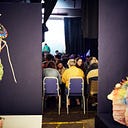In focus: The Next Step: An architectural exploration of the future for NIDA Lithuania.
What is the next step for Nida?
The Next Step is situated in the Lithuanian town of Nida in a unique arc of land called the Curonian Spit between the UNESCO protected sand dunes and the complex socio-political context of the Russian and Lithuanian boarder.
The framework was designed by Myself, Chloe Mcarey-Carne, and Dora Dixon. We had 16 participants to pool ideas surrounding Nida’s conservationist identity issues. The question: How do we tackle the difficult conservation issues that Nida faces? Artists and architects were are invited to contribute to the staircase by making a square which conceptualised a snapshot of a potential future for Nida. This involved a workshop process where we worked with designers to understand local level issues, design and co-build the interventions. In total there were 16 squares with designers from over ten nationalities.
The project started when we were given the opportunity to explore the small holiday town during an ITM. We took the time to speak to locals over a week long period, this revealed that Lithuanians have a very real and shared cross generational trauma. Fragmented understanding architecture and culture, and are struggling to orientate what is next for them.
Protection after the voilence.
Lithuania’s culture experienced violence and economic marginalisation during the Soviet Union. And after its fall, many of these issues still haunt the collective memory. As a response the holiday town of NIDA reacted with preservationism. The Unesco protection of NIDA meant different, fractured and disconnected authorities were given full responsibility to preserving different parts. For example: The Tree authorities want to preserve trees. Sand dune authorises to preserve dunes. The Local authorities want to preserve a single image of architecture. This all becomes more confused when wrapped in a UNESCO heritage package as it is not clear what each constituent is intended to preserve. it is unclear, but the locals feel it is ‘mans relationship with nature.’ That is to be preserved, no single aspect.
Curonian split
Nida’s economy relied on being a holiday resort for Russian tourists. Shifting ties with Russia meant losing a key economic position within the global economy. The split turned a unique landform into two distinct geopolitical zones with affected communities. As a result they created a reactionary heritage culture.
The material aesthetic of the Soviet Era architecture came to represent scar tissue to natives. Most were keen to differentiate nada from it’s recent past, which it hated. A sort of fishing village holiday resort image formed and space for escape. But from a psychoanalytic perspective Nida had a larger relationship with the rest of the country. It became a kind of dreamland, a collective representation of escape, So Nida is not just a holiday resort, it is this vision of Lithuania’s escapism. A position of safety.
Living memories
Today NIDA’s buildings resemble a gnome like painting of a distant forgotten past — something which it has rediscovered. However the physical reality of this exterior is sadly a facade, and much of this past never truly existed, at least not in the way it is presented — layers of humble stained timber cover the concrete caucus underneath. The image of Soviets concrete symbolise the tragedies of the era, Lithuanians in Nida also think yellow brickwork is considered to epitomise ‘ugliness’ and poor quality, and concrete similarly.Realising this we sought to provide an outlet for an important discussion.
The Next step was a proposal for a framework for cultural reinterpretation in this wider psychological and social context. As a series of ’squares’, where each square showed a potential direction for Nida, and a way in which the immense heritage issues could be overcome.
We decided there needed to be structure that gave an opening to the imagination for a new future of NIDA. Envisaging that the process of reimagining could be one of collective social healing — where discussion becomes more important than the built form alone. When Nida is a small town stuck in the past because it feels safe here — but what about a future of nida? What about the future of Lithuania?
The staircase itself
The starcase deconstructed and reconstructing desires of the people. For example, one piece by Mara showed an empty and isolated soviet era bus stop, a place of waiting without necessarily anything to wait for. Another peice my Povalas from lithuania showed a giant moss tower, a dialogue about daring and boldness in contemporary materials, which might form the basis for a different spirit of place overall. Could we think beyond the fishing village aesthetic and form a more refined understanding of the material spirit of nida? Another experiment showed a sort of dial where a person could flip bricks, outlining the changing perception of surrounding the bricks - where yellow bricks could be transformed one by one into red bricks, this was referencing the changing idea of beauty and memory surrounding post soviet brickwork. Two squares towards the top of the staircase were designed by a French team, these explored using nida as a space for freedom and play and were well loved by children who enjoyed playing on all of the different parts of the staircase.
As the staircase was at the boarder between Russia and Lithuania local politicians and shopkeepers engaged with discussions around the piece extensively with the peice, and it stimulated a dialogue.
